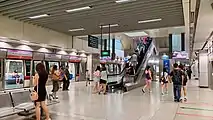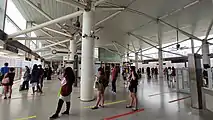Punggol MRT/LRT station
Punggol MRT/LRT station is a Mass Rapid Transit (MRT) and Light Rail Transit (LRT) station in Punggol, Singapore. It is currently an interchange station between the North East line (NEL) and Punggol LRT (PGLRT), and the only MRT station located within Punggol planning area. Stretching across Punggol Central, the station is situated near Punggol Temporary Bus Interchange and the retail development of Waterway Point.
NE17 PTC CP4 Punggol 榜鹅 பொங்கோல் Punggol | |||||||||||||||||||||||||||||||||||
|---|---|---|---|---|---|---|---|---|---|---|---|---|---|---|---|---|---|---|---|---|---|---|---|---|---|---|---|---|---|---|---|---|---|---|---|
| Mass Rapid Transit (MRT) / Light Rail Transit (LRT) station | |||||||||||||||||||||||||||||||||||
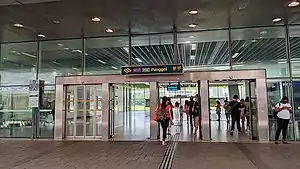 Exit A of Punggol station | |||||||||||||||||||||||||||||||||||
| Location | 70 Punggol Central Singapore 828868[1] | ||||||||||||||||||||||||||||||||||
| Coordinates | 1°24′19″N 103°54′08″E | ||||||||||||||||||||||||||||||||||
| Operated by | SBS Transit Ltd (ComfortDelGro Corporation) (North East MRT line, Punggol LRT line) | ||||||||||||||||||||||||||||||||||
| Line(s) | |||||||||||||||||||||||||||||||||||
| Platforms | 4 (2 island platforms) | ||||||||||||||||||||||||||||||||||
| Tracks | 6 (2 in future) | ||||||||||||||||||||||||||||||||||
| Connections | Punggol Bus Interchange, Taxi | ||||||||||||||||||||||||||||||||||
| Construction | |||||||||||||||||||||||||||||||||||
| Structure type | Underground (North East line and Cross Island line) Elevated (Punggol LRT line) | ||||||||||||||||||||||||||||||||||
| Platform levels | 2 | ||||||||||||||||||||||||||||||||||
| Parking | Yes (Waterway Point) | ||||||||||||||||||||||||||||||||||
| Bicycle facilities | No | ||||||||||||||||||||||||||||||||||
| Disabled access | Yes | ||||||||||||||||||||||||||||||||||
| History | |||||||||||||||||||||||||||||||||||
| Opened | 20 June 2003 (North East line) 29 January 2005 (LRT East Loop) 29 June 2014 (LRT West Loop) 2031 (Punggol extension) | ||||||||||||||||||||||||||||||||||
| Electrified | Yes | ||||||||||||||||||||||||||||||||||
| Passengers | |||||||||||||||||||||||||||||||||||
| November 2020 | 25,922[2] | ||||||||||||||||||||||||||||||||||
| Services | |||||||||||||||||||||||||||||||||||
| |||||||||||||||||||||||||||||||||||
| Location | |||||||||||||||||||||||||||||||||||
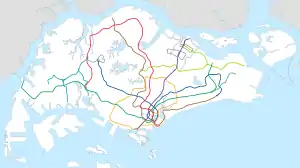 Punggol Punggol station in Singapore | |||||||||||||||||||||||||||||||||||
The station was completed on 20 June 2003 alongside the other NEL stations. It is currently the northern terminus on the North East line until the expected completion of Punggol Coast station in 2024. By 2031, the station will become the terminus of the future Cross Island line (CRL) Punggol extension from Pasir Ris station, making it a triple-line interchange station. The station is one of the longest stations on the network at 320 metres (350 yards) long with aluminium and steel cladding, which gives the station a futuristic look.
History
North East line (NEL) and LRT
Plans and studies were made since 1984 for a possible north-east line serving from Outram Park to Punggol via Dhoby Ghaut.[3][4][5] The plans for the line was approved by the Mass Rapid Transit Corporation (MRTC) in October 1987 and submitted to the government.[6] When the 16 NEL stations were revealed in March 1996, Punggol was confirmed to be the northern terminus of the line. However, it was not planned to be built until the area has been developed extensively.[7]
During the 1996 National Day Rally Speech, the then prime minister Goh Chok Tong announced that the station will serve the upcoming Punggol 21 development.[8] Contract 712 for the construction of Punggol NEL station and 1.3 kilometres (0.81 mi) of tunnels was awarded to Sato-Kogyo-Hock Lian Seng Joint Venture[9] at a contract sum of S$85.86 million (US$51.3 million) in March 1998.[10][11]
In July 1998, it was further announced that the station will be linked to the upcoming LRT system serving the area.[12] The contract for the design and construction of the 13-kilometre (8.1 mi) Punggol LRT system was awarded to a joint venture, comprising Singapore Technologies Industrial Corporation, Mitsubishi Heavy Industries and Mitsubishi Corporation, at a contract sum of S$656 million (US$391.97 million).[lower-alpha 1][12]
Constructed in the middle of the forest (eventually cleared to make way for the construction), the station site was not easily accessible. The Land Transport Authority (LTA) staff raised certain safety concerns especially for women staff using the 800-metre (2,600 ft) track.[13] To address this, the LTA provided bus service to transport people in and out of the site.[14] The staff encountered a few cobras during the station's construction, mainly killed and overrun by tractors.[14]
The NEL station opened on 20 June 2003.[15][16] On 29 January 2005, the station began to serve the east loop of the PGLRT.[17] On 29 June 2014, the station began to serve the west loop.[18]
Future plans and Cross Island line (CRL)
During the construction of the NEL station, a 40-by-40-metre (130 by 130 ft) box was already constructed beneath the NEL station to allow provisions for a possible future line.[19] The station box was reserved for the North Shore line, an LRT line that would link between Pasir Ris and Woodlands[20] or Sembawang.[21] First announced in December 1996, the line would have been built after the completion of developments in Simpang and Punggol.[20]
On 10 March 2020, the LTA announced that Punggol station will be the terminus of the proposed Cross Island line (CRL) Punggol extension. The Punggol extension consists of four stations between Pasir Ris and Punggol, going through Punggol Central and Lorong Halus. The extension is expected to be completed in 2031.[22][23][24]
Incidents
On 27 February 2020, a power fault along the NEL resulted in service disruptions to the Punggol, Sengkang and Buangkok stations.[25][26] At 5:36 am, a shuttle train service was provided which operated on a single platform between the Punggol and Buangkok stations. In order to facilitate maintenance functions, the power source to the tracks between the Hougang and Punggol stations was switched off. Additionally, free regular and bridging bus services were provided to serve these stations. The repair works were completed by 11:49 am and usual service along the entire NEL resumed at 12:14 pm.[27][28] Investigations later revealed that a broken contact wire affected the power source to trains launching from Sengkang Depot, causing the service disruptions.[25][28][29]
Station details
Services
The station currently serves both the Punggol LRT line (PGLRT) and the North East line (NEL). The station code is NE17/PTC as reflected on official maps.[30] The station is the current terminus of the NEL, with the next station being Sengkang station.[30] The station will be extended one stop to Punggol Coast station in 2024.[31][32][33] The NEL platforms operate between 5:40 am and 11:30 pm daily.[34]
On the PGLRT, the station is between the Cove and Damai stations on the East loop, and between the Sam Kee and Soo Teck stations on the West loop.[30] The LRT platforms operate between 5:20 am and 12:40 am daily.[35]
Design
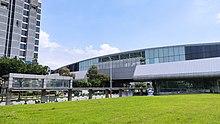
The station currently has three levels and four entrances.[36] Designed by two architectural firms – 3HPArchitects and Farrells[37][38] – the station is intended to be integrated with the LRT station and the bus interchange.[39] The station's curved aluminium and stainless steel cladding gives it a futuristic outlook, best reflecting the developments of Punggol 21.[36][40]
Punggol station is the longest station on the NEL, spanning over Punggol Central at 320 metres (350 yards). This was to accommodate the bus stops, taxi stands and passenger drop-off points along that road.[40] Being above-ground, the station has higher air-conditioning demands. Hence, more room was needed for the air-conditioning plant rooms. Due to its extensive structure (occupying an area of about 21,920 m2 (26,220 sq yd))[38] the station has the most lifts (6) on the line.[36][40]
Public artwork
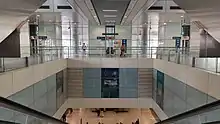
Punggol station features an artwork Water, Landscape & Future by Goh Beng Kwan as part of the network's Art-in-Transit programme.[lower-alpha 2][41][42] The artwork consists of a set of nine glass paintings displayed around the concourse, with each 3-by-2-metre (9.8 by 6.6 ft) glass panel reflecting natural light in the station.[43] The glass paintings represents elements of water, the seaside, kampongs and trees, with pieces of materials embedded in the glass to create a shimmering effect.[41][42]
In the work, the artist uses various colours (blue/turquoise for the sea, yellow/brown/sienna for the kampungs and green for the trees) which reflects his memories of Punggol's past. While his inspiration is from the past, the artist used a contemporary style for this work, intending for his work to remain "fresh and appealing" to the residents of Punggol then, now and the future. First creating his work using oil and acrylic on canvas, Goh has the computer-generated copies put up in a 3D-model of the station. Presenting his work, the artist recounted that he had a difficult time convincing the Art Review Panel that the work could last a long time in a public place.[43]
This was the first time Goh used glass as a medium. Creating the work required patience, as Goh had to repeatedly fire the glass after applying colour on the panel. As glass is fragile, a panel broke apart after being fired seven times. Recounting this as a "heartbreak", the artist went on to seek help from Howard Chua of Sun Glass. Chua then experimented with materials and colours to create the textures and colours closer to the originals. He used a unique method of integrating glass with glass and other materials. Hoping to recreate the textures of cloth and paper in the originals, new materials were introduced, while firing techniques were refined. The artist was fascinated by the "element of spontaneity" during the firing process, as the colours produced after the process vary greatly with different methods.[44]
Seeing the artwork for himself, Goh realised that he could continue conveying himself through glass to accomplish his artistic vision. The artist "took pride" in the fact that he only needed natural lighting for his works, instead of special lighting. He hoped that his work would signal to commuters that they have arrived at Punggol. Additionally, for the elderly, he hoped the work will make them "think of the sea" and their youth.[45]
Notes and references
Footnotes
- The contract also includes the Sengkang LRT line
- Public art showcase which integrates artworks into the MRT network
References
- "70 Punggol Central (S)828868". streetdirectory.com. 21 December 2020. Archived from the original on 2 September 2018. Retrieved 21 December 2020.
- "Land Transport DataMall". mytransport.sg. Archived from the original on 21 August 2020. Retrieved 11 December 2020.
- "Study into MRT north-east line". The Straits Times. 26 September 1984. Archived from the original on 25 December 2020. Retrieved 20 December 2020.
- "Serangoon and Hougang may be next on MRT line". The Straits Times. 30 March 1986. Archived from the original on 25 December 2020. Retrieved 20 December 2020.
- "New MRT extension to Punggol and Jalan Kayu". The Business Times. 8 August 1988.
- "MRTC okays extension to Punggol, Jalan Kayu". The Straits Times. 6 October 1987. Archived from the original on 25 December 2020. Retrieved 20 December 2020.
- "Residents in N-E corridor happy with station sites". The Straits Times. 6 March 1996. p. 16.
- Leong 2003, p. 189.
- Leong 2003, p. 197.
- "Projects". hlsgroup.com.sg. Archived from the original on 21 April 2020. Retrieved 23 April 2020.
- "Punggol MRT station to get an early start". Business Times. 30 March 1998. p. 2.
- "Speech By Mr Mah Bow Tan Minister For Communications Sengkang And Punggol LRT Systems Contract Award Ceremony On 4 July 1998, 11 a.m." nas.gov.sg. 4 July 1998. Archived from the original on 19 October 2020. Retrieved 20 December 2020.
- Leong 2003, p. 192–193.
- Leong 2003, p. 193.
- "North East Line Opens for Passenger Service!". www.lta.gov.sg. 20 June 2003. Archived from the original on 3 December 2007.
- "It's a smooth ride on NEL – mostly". The Straits Times. 21 June 2003. p. 1.
Minor hitches aside, the North-East Line got off to a smooth start yesterday
- "Punggol LRT and Sengkang LRT West Loop to Commence Revenue Service on 29 January 2005". SBS Transit. 10 January 2005. Archived from the original on 30 August 2019. Retrieved 30 August 2019.
- "Punggol West LRT System to Commence Passenger Service and North East line to Add More Train Trips". SBS Transit. 18 June 2014. Archived from the original on 22 June 2014. Retrieved 29 June 2014.
- Leong 2003, p. 196–197.
- Veloo, Ravi (15 December 1996). "Pasir Ris, Woodlands LRT link under study". The Straits Times.
- "Past Concept Plans". Urban Redevelopment Authority. 12 December 2020. Archived from the original on 3 September 2020. Retrieved 21 December 2020.
- "LTA | News Room | news-releases | Cross Island Line – Punggol Extension: Better Rail Connectivity for Punggol and Pasir Ris Residents". www.lta.gov.sg. Archived from the original on 10 March 2020. Retrieved 10 March 2020.
- "Punggol extension on Cross Island Line to begin construction in 2022". CNA. Archived from the original on 10 March 2020. Retrieved 10 March 2020.
- "Punggol residents to get four more train stations by 2031". The Straits Times. 10 March 2020. Archived from the original on 10 March 2020. Retrieved 10 March 2020.
- "North East Line (NEL) services affected by power fault - SBSTransit". www.sbstransit.com.sg. Archived from the original on 11 July 2020. Retrieved 11 July 2020.
- "Power fault causes 6-hour disruption on North East Line". The New Paper. 28 February 2020. Archived from the original on 12 July 2020. Retrieved 11 July 2020.
- "North East Line hit by 6-hour power fault, LTA and SBS Transit investigating". The Straits Times. 27 February 2020. Archived from the original on 11 July 2020. Retrieved 11 July 2020.
- "Power fault causes 6-hour disruption on North East Line". The Straits Times. 28 February 2020. Archived from the original on 11 July 2020. Retrieved 11 July 2020.
- "Power fault disrupts train service along North-East Line during morning rush hour". CNA. Archived from the original on 11 July 2020. Retrieved 11 July 2020.
- "MRT System Map" (PDF). www.lta.gov.sg. Archived (PDF) from the original on 21 August 2020. Retrieved 21 December 2020.
- Yong, Clement (13 November 2020). "Punggol Coast MRT station ready by 2024, 40% of work completed". The Straits Times. Archived from the original on 13 November 2020. Retrieved 13 November 2020.
- Abdullah, Zhaki (13 November 2020). "Opening of new Punggol Coast MRT station to be delayed to 2024". CNA. Archived from the original on 15 November 2020. Retrieved 15 November 2020.
- "Future System Map" (PDF). www.lta.gov.sg. Archived (PDF) from the original on 9 September 2020. Retrieved 9 September 2020.
- "Train Service Information - Punggol NEL". SBSTransit (in Kinyarwanda). Archived from the original on 25 December 2020. Retrieved 21 December 2020.
- "Train Service Information - Punggol PGLRT". SBSTransit (in Kinyarwanda). Archived from the original on 25 December 2020. Retrieved 21 December 2020.
- "North East Line: Punggol Station". www.lta.gov.sg. Archived from the original on 3 December 2007. Retrieved 21 December 2020.
- Tan 2003, p. 179.
- "Punggol Station". Farrells. 19 July 2017. Archived from the original on 21 December 2020. Retrieved 21 December 2020.
- "North East Line: Punggol Station". www.lta.gov.sg. Archived from the original on 3 December 2007. Retrieved 21 December 2020.
- Leong 2003, p. 194.
- "Getting Around | Public Transport | A Better Public Transport Experience | Art in Transit". www.lta.gov.sg. Land Transport Authority. Archived from the original on 21 April 2020. Retrieved 11 July 2020.
- "Art-in-Transit". SBSTransit. 15 December 2020. Archived from the original on 21 April 2020. Retrieved 22 December 2020.
- Tan 2003, p. 166.
- Tan 2003, p. 167.
- Tan 2003, p. 168.
Bibliography
External links
 Media related to Punggol MRT/LRT Station at Wikimedia Commons
Media related to Punggol MRT/LRT Station at Wikimedia Commons- Official website
